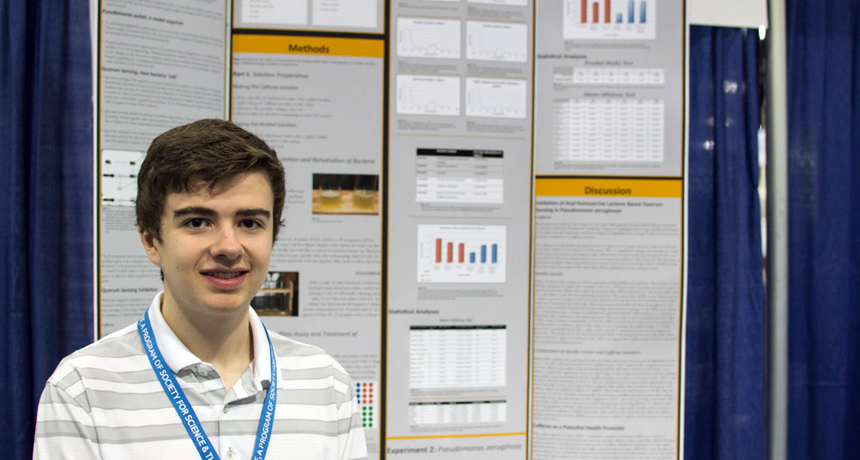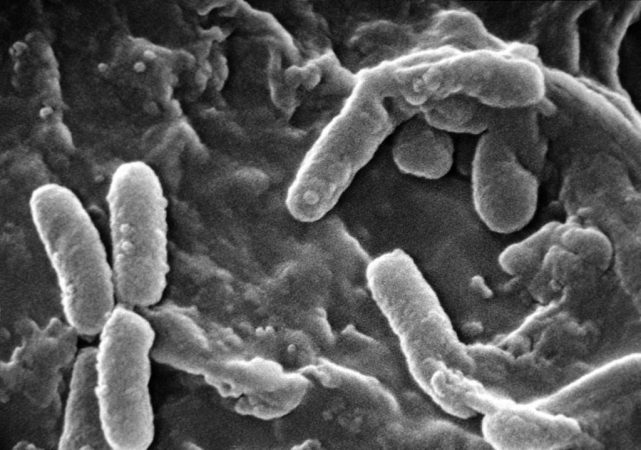Convincing bacteria they’re alone
A teen researcher may have come across a way to keep some bacteria from turning deadly

Nicholas Miller, 15, who attends West Linn High School in Oregon, found that caffeine could stop or delay a dangerous bacterium from changing from a benign form to its disease-causing version.
Patrick Thornton/SSP
By Sid Perkins
LOS ANGELES — In novels and short stories, there are many examples of characters with split personalities. Under the light of a full moon, people who have been cursed or bitten by werewolves change into the vicious creatures themselves. When the friendly Dr. Jekyll drinks a certain potion, he transforms into the murderous Mr. Hyde. But an Oregon teen has found a way to keep such a scary alter ego from emerging — at least among some potentially deadly bacteria.
Nicholas Miller has focused his research on the behavior of Pseudomonas aeruginosa (SU-duh-MOH-nas AIR-oo-gin-OH-sa). These bacteria can exhibit true split personalities, explains the 11th-grader from West Linn High School in Oregon. They can switch from benign to deadly in a jiffy. And you never know where they might be hiding.
This germ can reside in soil and water, or on — and sometimes in — many animals, including people. “It typically likes warm, dark, moist places,” Nicholas explains. Skin can host the microbes. So can medical equipment, including devices with tubes that help people breathe or pass urine. Fortunately, these bacteria usually pose no problem.
Still, in many P. aeruginosa infections, groups of bacteria team up to form a nasty, sticky layer called a biofilm. This helps protect germs in the biofilms from drugs that might be unleashed against them. Adding to the problem, many strains of the microbes no longer respond to antibiotics that once would have killed them.

Scientists don’t fully understand why the germ sometimes makes that Jekyll-to-Hyde transformation, Nicholas notes. But it seems to take place after some members of its species begin secreting certain chemicals, he says. When those chemicals are present at high levels, individual bacteria seem to realize they’re no longer alone.
This ability to sense that a critical number of their kind is present is called “quorum sensing.” (“Quorum” comes from the Latin language. In modern terms, it means “the minimum number of people needed to be present for a committee to make a decision.”) Bacteria are not the only organisms to rely on quorum sensing. Many social insects also use the tactic to sniff out whether their army has raised enough troops to launch a potentially successful attack.
Recently, scientists studying a different bacterium were able to stop its transition from benign to infectious, Nicholas notes. They applied caffeine and vanilla extract to interfere with its quorum sensing. The West Linn teen decided to probe whether these substances might similarly tame P. aeruginosa.
Studying its less deadly cousin
Because P. aeruginosa can very dangerous, Nicholas worked with the germ’s close, but less-infectious, cousin: P. putida. The genetic machinery of the two species is quite similar, he notes. So, tests with one should provide a good gauge of whether the treatment also would work against the other.
Nicholas grew several containers of P. putida. Then he added a test solution to each container. One solution contained caffeine dissolved in water. Another had vanilla dissolved in alcohol. A third solution was plain water. The last was plain alcohol, dissolved in water to the same concentration present in the vanilla extract. That let him compare the results he obtained with the solutions that contained caffeine or the vanilla extract. If the last two had no effect, then any changes in bacterial behavior must be due to the target substances (caffeine or vanilla) and not the liquids in which they had been dissolved.
After five days, Nicholas measured the concentration of a substance called AHL in each container. AHL (short for N-Acyl homoserine lactone) is the signaling molecule that P. putida uses in quorum sensing.
Neither the alcohol nor the water altered the germs’ AHL levels. But the vanilla treatment caused a 10 percent decrease in AHL level. And the caffeine solution caused a whopping 55 percent drop. Nicholas reported his findings here, last week, as a finalist at the Intel International Science and Engineering Fair, or Intel ISEF. The competition was created by the Society for Science & the Public and is sponsored by Intel. (SSP publishes Science News for Students.) Each year, Intel ISEF showcases some of the best high school science projects from around the globe.
Nicholas counted the number of P. putida cells in each container at the beginning and the end of the five-day tests. They did not change. The caffeine and vanilla did not kill the bacteria, says Nicholas. Those solutions simply prompted a change in the germs’ behavior. The treated germs now failed to hail others of their species as loudly with that “I’m here” signal.
The results suggest that caffeine might one day offer a new way to treat P. aeruginosa infections, Nicholas says. That could be especially important for cystic fibrosis patients. The germ often causes pneumonia in patients with that lung disease. It is the number one killer of those patients, he notes.
Power Words
antibiotic A germ-killing substance prescribed as a medicine (or sometimes as a feed additive to promote the growth of livestock). It does not work against viruses.
biofilm A gooey community of one or more different types of microbes that essentially glues itself to some solid surface. Living in a biofilm is one way microbes protect themselves from stressful agents (such as poisons) in their environment.
caffeine A stimulant, which activates the nervous system and heart. The leaves, seeds and fruits of many plants contain caffeine. In coffee plants and tea bushes, caffeine acts as a natural pesticide. It will kill or harm insects that attempt to dine on the plant. Caffeine is also toxic to some types of plants, bacteria — even frogs and dogs.
pathogen An organism that causes disease.
Pseudomonas aeruginosa This common bacterium, whose name is sometimes shortened to P. aeruginosa, can cause disease in animals, including people. It lives in soil and water, and it is also can live on human skin. Under normal conditions it is harmless, but in certain cases its infections may turn deadly.
quorum sensing The ability of organisms to gauge the presence of others of their kind, often through chemicals that the organisms produce and release into the environment. Once individuals recognize a certain number of organisms are close by, their behavior often changes. Bacteria can turn from benign to deadly, for example.
resistance (as in drug resistance) The reduction in the effectiveness of a drug to cure a disease, usually a microbial infection.
signaling molecule A substance created by an organism and released into the environment. In organisms that use quorum sensing, signaling molecules are used to broadcast an individual’s presence to similar organisms nearby.







